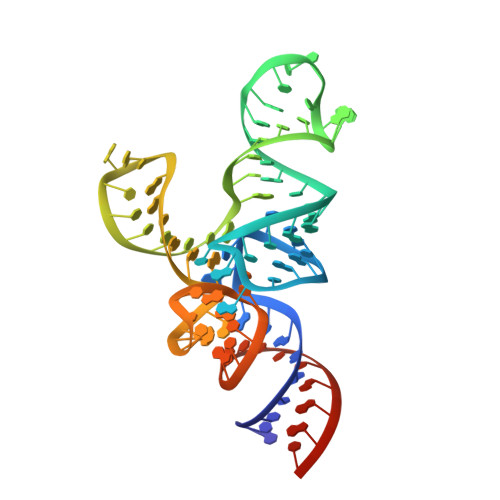Crystal structure of human selenocysteine tRNA.
Itoh, Y., Chiba, S., Sekine, S., Yokoyama, S.(2009) Nucleic Acids Res 37: 6259-6268
- PubMed: 19692584
- DOI: https://doi.org/10.1093/nar/gkp648
- Primary Citation of Related Structures:
3A3A - PubMed Abstract:
Selenocysteine (Sec) is the 21st amino acid in translation. Sec tRNA (tRNA(Sec)) has an anticodon complementary to the UGA codon. We solved the crystal structure of human tRNA(Sec). tRNA(Sec) has a 9-bp acceptor stem and a 4-bp T stem, in contrast with the 7-bp acceptor stem and the 5-bp T stem in the canonical tRNAs. The acceptor stem is kinked between the U6:U67 and G7:C66 base pairs, leading to a bent acceptor-T stem helix. tRNA(Sec) has a 6-bp D stem and a 4-nt D loop. The long D stem includes unique A14:U21 and G15:C20a pairs. The D-loop:T-loop interactions include the base pairs G18:U55 and U16:U59, and a unique base triple, U20:G19:C56. The extra arm comprises of a 6-bp stem and a 4-nt loop. Remarkably, the D stem and the extra arm do not form tertiary interactions in tRNA(Sec). Instead, tRNA(Sec) has an open cavity, in place of the tertiary core of a canonical tRNA. The linker residues, A8 and U9, connecting the acceptor and D stems, are not involved in tertiary base pairing. Instead, U9 is stacked on the first base pair of the extra arm. These features might allow tRNA(Sec) to be the target of the Sec synthesis/incorporation machineries.
- Department of Biophysics and Biochemistry, Graduate School of Science, The University of Tokyo, 7-3-1 Hongo, Bunkyo-ku, Tokyo 113-0033, Japan.
Organizational Affiliation:
















